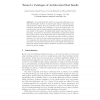Free Online Productivity Tools
i2Speak
i2Symbol
i2OCR
iTex2Img
iWeb2Print
iWeb2Shot
i2Type
iPdf2Split
iPdf2Merge
i2Bopomofo
i2Arabic
i2Style
i2Image
i2PDF
iLatex2Rtf
Sci2ools
QOSA
2009
Springer
2009
Springer
Toward a Catalogue of Architectural Bad Smells
Abstract. An architectural bad smell is a commonly (although not always intentionally) used set of architectural design decisions that negatively impacts system lifecycle properties, such as understandability, testability, extensibility, and reusability. In our previous short paper, we introduced the notion of architectural bad smells and outlined a few common smells. In this paper, we significantly expand upon that work. In particular, we describe in detail four representative architectural smells that emerged from reverse-engineering and re-engineering two large industrial systems and from our search through case studies in research literature. For each of the four architectural smells, we provide illustrative examples and demonstrate the smell’s impact on system lifecycle properties. Our experiences indicate the need to identify and catalog architectural smells so that software architects can discover and eliminate them from system designs.
Architectural Smells | Lifecycle Properties | QOSA 2009 | Representative Architectural Smells | Software Engineering |
| Added | 27 May 2010 |
| Updated | 27 May 2010 |
| Type | Conference |
| Year | 2009 |
| Where | QOSA |
| Authors | Joshua Garcia, Daniel Popescu, George Edwards, Nenad Medvidovic |
Comments (0)

